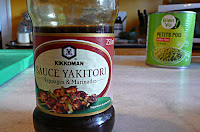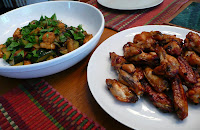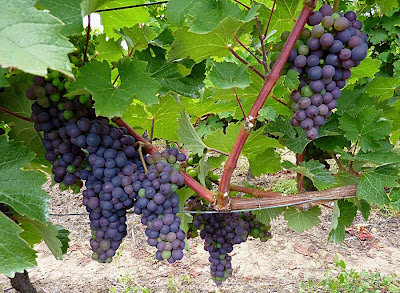At first I thought it was car headlights from out in the vineyard. There was no sound. The lights flashed twice. A few seconds later, they flashed twice again. And then a third time. Must be a car on the dirt road, and its headlights are lighting up the room every time it hits one of the deep ruts cut across the road to let rainwater drain off. However, it's rare to see a car out there at night.
No, it was lightning. It was far off to the southwest. At first I thought the storm would pass by south of us. Instead, it came right over. It was 5:10 a.m. I got up and started closing the windows upstairs, and then I came downstairs to see if everything was closed up down here. Callie was nervous.
Then there were 8 or 10 bolts of lightning pretty close to the house. Some of them were big streaks going up almost vertically from the ground to a point high in the sky. I was standing at the window, watching, when one bolt shot up, and it left its image on my retina for a second or so. The thunder was the kind you not only see but feel. The wind picked up and a hard rain fell. It didn't last long. By 5:35, it was pretty much over. The «
barnum » didn't blow away.
So much for sleeping late on a Sunday morning. It was hot yesterday afternoon, and the storms were predicted by MétéoFrance. They say some more will probably pass through during the day today, with temperatures near 30ºC. That's the mid-80s F.
Yesterday we were invited to lunch by our neighbors — the ones who have their summer/country house across the street and who spend July and August here every year. Two of their daughters (in their mid-40s, I'd say), one son-in-law, several grandchildren and great-grandchildren, and two couples we hadn't met before were the other guests.
One of the M. and B.'s granddaughters is enormously pregnant and just got married in July. She having her third baby. Another must be about 20 and just got her baccalauréat. She's kind of plump and very sassy, in a good way. There were a couple of great-grandkids running around too.
Walt decided not to wear his
collier cervical, the neck brace, to lunch. When he took it off to take his shower before we went over there, he noticed that he has a rash on his neck. It's been hot, and our sweaty necks are not used to being bound up in such weather.
At lunch — a big salad of fresh local tomatoes, hard-boiled eggs, and slices of mozzarella to start, along with some
concombres à la crème, followed by a very impressive cooked
brochet (a river fish called a perch-pike) served cold, plus cheeses and desserts — the discussion was lively and hard to follow. We were inside — it was too hot outside, with the sun was beating down — and there were about 15 of us around a big rectangular table.
The discussion turned to the current controversies surrounding the Roms (gypsies who are from Romania and Bulgaria, mostly) and the
gens du voyage (nomadic people who have lived in France for centuries and who have French nationality). It's a very confusing subject because there are so many groups concerned —
gitans, Romanichels (called
Roms), Manouches, and other travelers and tinkers.
It was obvious that the French people were upset about the
Roms, who are being expelled from France by the Sarkozy government. "They'll take a payment and a plane ticket from the French government, fly back to Romania, and then they'll be back in France before long, maybe using a different name, and the whole process will start over again," one person said. "And who pays? WE DO!" Meaning "ordinary" French citizens and taxpayers.
The
Roms (foreigners but European) have the right to enter France without a visa and to look for work. They aren't allowed to stay, it seems, if after three months they haven't found a job. At that point, they are illegal. A lot of them live in camps, shanty towns, on the northern fringes of the Paris area. Some are beggars. Others collect trash and recyle or try to resell it. I'm sure many are legitimately employed. They are seen as parasites and troublemakers.
The
gens du voyage or "traveling people" are upset that the government doesn't provide them with adequate campgrounds where they can park their trailers and RVs and hook up to electricity and water. The law says that local authorities must provide such facilities. The travelers pay a nominal amount for the services. They've always lived that way, in their trailers.
The "travelers" have been demonstrating for better facilities down in Bordeaux over the past few days. They don't like the campground the authorities want them to use there. The other day, they parked all their vehicles and trailers on a major highway bridge outside Bordeaux, causing traffic chaos.
Les gens du voyage don't want to be put in the same category as the foreign Roms. Most people don't understand the differences.
As I said, it's complicated. I sure don't understand it all.
At lunch, the discussion was loud and vigorous, with people talking over each other to express their outrage and emotion. Those kinds of discussions are hard for Walt and me to follow, much less participate in. It doesn't help that we sometimes feel the people with the most sharply expressed opinions don't really know what they are talking about. You hear people saying: "I'm not racist, but..." And then you hear the racist, or ethnically insensitive, remark. Those are the kinds of free-for-alls that I prefer to avoid.
Meanwhile, Walt took his anti-inflammatory medication in the middle of the meal, as per doctor's orders. After a few minutes, I realized he was fading. He looked pale and a little confused. Our neighbor M. also noticed and asked him to come sit on a sofa with her and rest for a minute or two. I was tired and confused by all the loud arguing.
A few minutes later, I excused us and we walked across the street to our house. I'm sure some of the people thought our exit was abrupt, and they probably think it was strange that we didn't join in all the arguments and rants. One man in particular kept looking at me, almost challenging me to say what I thought about the gypsies and the travelers. I wasn't going to be sucked in.
I'm sure M. made apologies for us, in a good way. She seems to be kind of a peacekeeper. She has seven children, after all. Sometimes she gets hot under the collar — about cat poop, for example — but not too often. When we got home, Walt stretched out on the couch and slept for about two hours. That was the drugs talking.
 The plaque next to this work said it dates from the late 1500s
The plaque next to this work said it dates from the late 1500s
























































